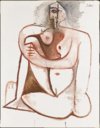Movement in art – art in movement
Dramatic gestures, shimmering brushstrokes or performance – movement is a central theme of art. As paradoxical as it may seem, overcoming the rigidity of the motif on the canvas or in marble by means of illusion was an essential goal of artistic activity. Colour, light and composition create liveliness in the representations. The Industrial Revolution brought even more movement into life and thus also into art. In 1863 Charles Baudelaire demanded that quickly executed pictures should reflect the movement of modern life. This can be seen in the rapidly applied brushstrokes of impressionist works as well as in the sculptures of Edgar Degas, who captures his dancer at the moment of movement. Later, Ernst Ludwig Kirchner drew lines of movement around his dancing couple. In the 1960s and 70s, the works of art themselves began to move and kinetic objects were created. Mirrors break the light and change the perception of space and mirror image through their multi-perspective orientation. In the performance, the human body becomes the material itself – bodies measure the world, document movement in space. In contemporary art, painting finally enters space and becomes a moving sculpture that also involves the viewer and his movement.
-
![Sandmühle, Günther Uecker]() Günther UeckerSandmühle
Günther UeckerSandmühle -
![Suck and pull your pants down (for peace), Tobias Rehberger]() Tobias RehbergerSuck and pull your pants down…
Tobias RehbergerSuck and pull your pants down… -
![Weißer Rotor, Heinz Mack]() Heinz MackWeißer Rotor
Heinz MackWeißer Rotor -
![Drehende Tänzerin, Ernst Ludwig Kirchner]() Ernst Ludwig KirchnerDrehende Tänzerin
Ernst Ludwig KirchnerDrehende Tänzerin -
![13 R/11 (where R = Ryoanji), John Cage]() John Cage13 R/11 (where R = Ryoanji)
John Cage13 R/11 (where R = Ryoanji) -
![Judith enthauptet Holofernes, Peter Paul Rubens]() Peter Paul RubensJudith enthauptet Holofernes
Peter Paul RubensJudith enthauptet Holofernes -
![Wind I (David), Isa Genzken]() Isa GenzkenWind I (David)
Isa GenzkenWind I (David) -
![Daseinsrenovierung, aus der Werkgruppe "Desaströses Ich", Jürgen Klauke]() Jürgen KlaukeDaseinsrenovierung, aus der Werkgruppe "Desaströses Ich"
Jürgen KlaukeDaseinsrenovierung, aus der Werkgruppe "Desaströses Ich" -
![S2-P2-DB28 from Scumak No. 2 (Auto Sculpture Maker), Roxy Paine]() Roxy PaineS2-P2-DB28 from Scumak No. 2…
Roxy PaineS2-P2-DB28 from Scumak No. 2… -
![Tänzerin, den rechten Fuß in der rechten Hand haltend, Edgar Degas]() Edgar DegasTänzerin, den rechten Fuß in der rechten Hand haltend
Edgar DegasTänzerin, den rechten Fuß in der rechten Hand haltend -
![KOEB, Victor Vasarely]() Victor VasarelyKOEB
Victor VasarelyKOEB -
![Rotklang, Ernst Wilhelm Nay]() Ernst Wilhelm NayRotklang
Ernst Wilhelm NayRotklang -
![Femme accroupie, Pablo Picasso]() Pablo PicassoFemme accroupie
Pablo PicassoFemme accroupie -
![Ein Seesturm an der norwegischen Küste, Andreas Achenbach]() Andreas AchenbachEin Seesturm an der norwegischen Küste
Andreas AchenbachEin Seesturm an der norwegischen Küste -
![Modefoto, Edward Steichen]() Edward SteichenModefoto
Edward SteichenModefoto -
![Die Musik kommt, Louise Rösler]() Louise RöslerDie Musik kommt
Louise RöslerDie Musik kommt -
![Erscheinung im Walde (aus Dornröschen), Moritz von Schwind]() Moritz von SchwindErscheinung im Walde (aus Dornröschen)
Moritz von SchwindErscheinung im Walde (aus Dornröschen) -
![Electric Night, Helmut Middendorf]() Helmut MiddendorfElectric Night
Helmut MiddendorfElectric Night -
![Die Woge, Gustave Courbet]() Gustave CourbetDie Woge
Gustave CourbetDie Woge -
![Villa am Meer, Arnold Böcklin]() Arnold BöcklinVilla am Meer
Arnold BöcklinVilla am Meer -
![Sommerlandschaft, Camille Corot]() Camille CorotSommerlandschaft
Camille CorotSommerlandschaft -
![Lesendes Mädchen, Auguste Renoir]() Auguste RenoirLesendes Mädchen
Auguste RenoirLesendes Mädchen
























